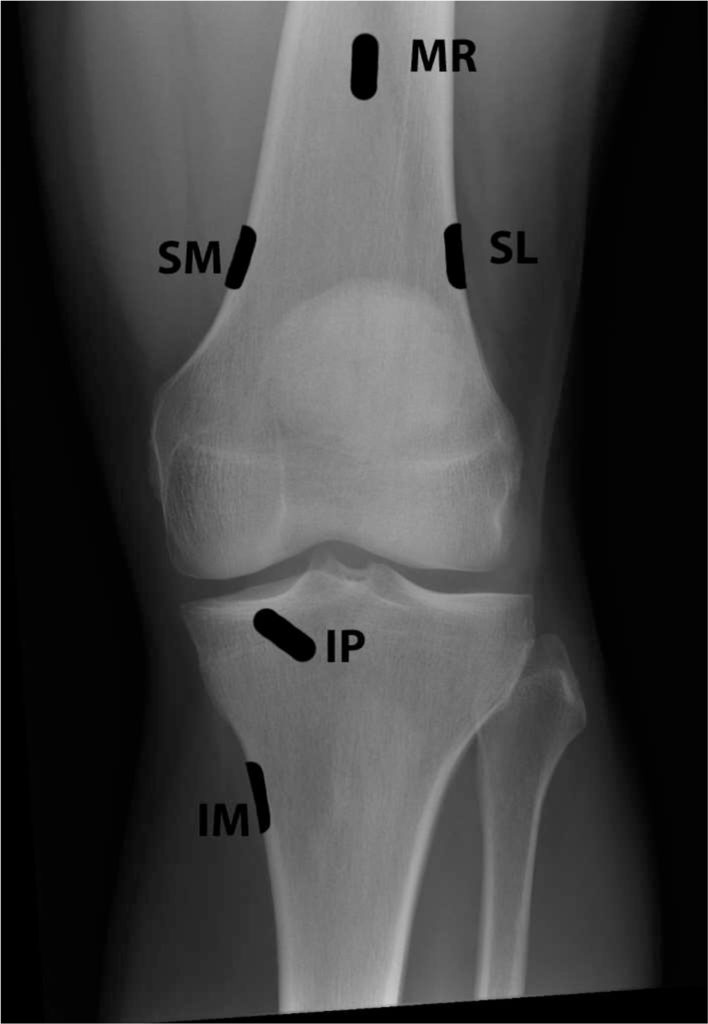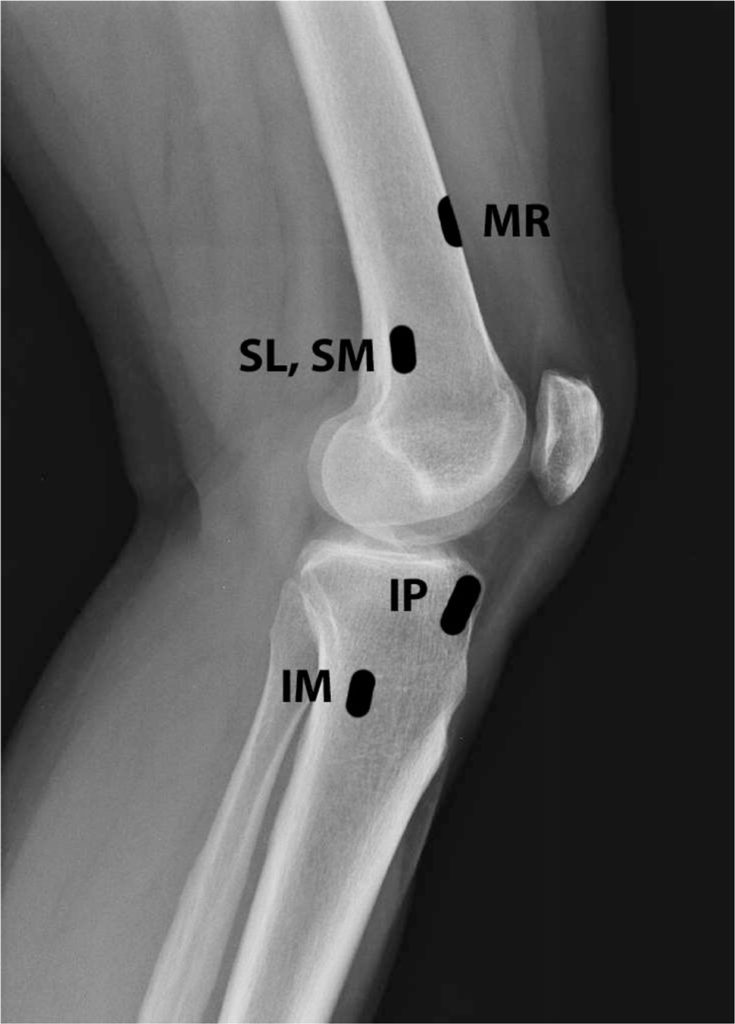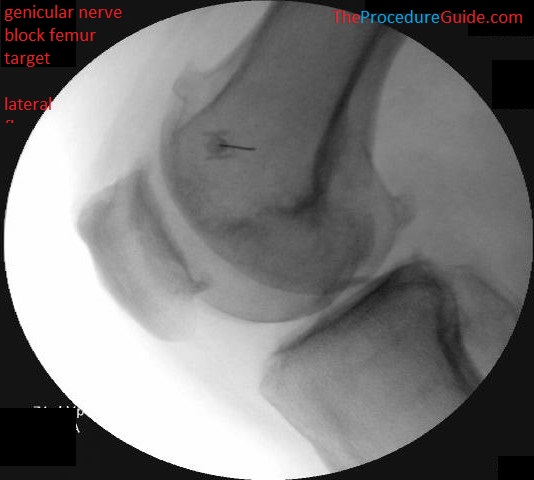Table of Contents
Name of Procedure
- Diagnostic Genicular Nerve Block (GNB)
- Therapeutic Genicular Nerve Block (GNB)
Sample Opnote
Goal
To block and/or administer medications to the genicular nerves that innervate the knee.
Indications
A diagnostic genicular nerve block might be performed to temporarily ameliorate pain from the knee from a variety of causes. It has the benefit of treating many causes such as arthritis, intraarticular pathology and even pain in patients who have had prior surgery or total and partial knee replacements.
This makes the procedure an option when intra articular treatments, such as a knee steroid or hyaluronic acid injection, aren’t an option.
The temporary block provides diagnostic value because a temporary relief in pain can help to determine if the knee is the source of the pain. A single block, or two blocks as part of a double comparative set of diagnostic blocks, might help inform if a radiofrequency ablation of the genicular nerves should be performed for the patient.
A therapeutic genicular nerve block (such as injection with a steroid) might be performed to ameliorate pathology around the nerves themselves, such as if a patient develops neuritis of the nerves after radiofrequency ablation/neurotomy/rhizotomy.
Contraindications
Anatomy
The knee is innervated by several genicular nerves. These nerves are articular branches formed from the femoral, saphenous, common peroneal, tibial and obturator nerves. There are several branches, but the following 3 are the ones targeted for treatment. They run along the bones, which give us fluoro targets:
- Superior lateral (SL) (along femur)
- Superior medial (SM) (along femur)
- Inferior medial (IM) (along tibia)


Equipment/Skills/Setup
Core Equipment/Disposables: See our disposables/equipment article for “core” items that are common to all procedures.
Special items and suggested setup for this procedure (see quick guide video above for example tray prep):
- 6-10cc local anesthetic as your injectate in a 10cc syringe
- 25g x 1.5″ hypodermic needle as your primary needle
Landmarks and Patient Positioning
- Position the patient in a basic supine position.
- Bend the operative leg to about 45 degrees or a little less and keep the contralateral leg straight. (The goal is just to keep the non-operative leg out of the way while getting a lateral view)
- Alternatively you could bend the non-operative leg and keep the operative leg flat.
- Position the patient/bed so that the bottom of the c-arm can go under the table below the knee, then simply rotate for a lateral view of the knee.
Technique
- Start with your lateral view of the knee and place a pointer right over your first target: either the lateral or medial femoral targets (SM and SL in the diagram above).
- Then simply insert your 25g x 1.5″ hypodermic needle “down the barrel” till you contact bone.
- Inject medication.
- Repeat for the other side of the femur and then for the tibial target (IM in the diagram above)
Images below show all needles at all 3 targets:

genicular nerve block lateral fluoroscopy with needle at femoral target 
genicular nerve block lateral fluoroscopy with needle placed at medial and lateral targets 
genicular nerve block lateral fluoroscopy with needle at tibia target
Tips
- NEEDLE CHOICE: Usually these bones are superficial enough that you can get to it with a basic 25g x 1.5″ hypodermic needle.
- This way you don’t have to use a quincke needle, and since you’re just using a 25g you probably don’t need to anesthetize the skin (it’s the same needle you would use to anesthetize so instead of doing 2 pokes with the same needle, just do the one poke).
- Also, you probably don’t need a bent needle since you’re traveling a short distance.
- If it isn’t long enough simply inject 1% lidocaine while pulling the needle out and then re-insert a longer quincke needle to reach your target.
References
Procedure Related
- Radiofrequency techniques to treat chronic knee pain: a comprehensive review of anatomy, effectiveness, treatment parameters, and patient selection
- Broad overview of many topics related to knee pain and RF in the pain literate.
- Good review of knee neuroanatomy
- Reviews many studies about RF for the knee and summarizes different RF modalities used in different studies along with their results.
- Prospective, Multicenter, Randomized, Crossover Clinical Trial Comparing the Safety and Effectiveness of Cooled Radiofrequency Ablation With Corticosteroid Injection in the Management of Knee Pain From Osteoarthritis
- Reviews some technique and has images for genicular block and RF.
General Clinical
- Radiofrequency treatment relieves chronic knee osteoarthritis pain: a double-blind randomized controlled trial
- Kim SY, Le PU, Kosharskyy B, et al. Is genicular nerve radiofrequency ablation safe? A literature review and anatomical study. Pain Physician. 2016;19(5):E697–E705. [PubMed] [Google Scholar]
- Davis T, Loudermilk E, Depalma M, et al. Prospective, multicenter, randomized, crossover clinical trial comparing the safety and effectiveness of cooled radiofrequency ablation with corticosteroid injection in the management of knee pain from osteoarthritis. Reg Anesth Pain Med. 2018;43(1):84–91. [PMC free article] [PubMed] [Google Scholar]
- Qudsi-Sinclair S, Borrás-Rubio E, Abellan-Guillén JF, Padilla del Rey ML, Ruiz-Merino G. A comparison of genicular nerve treatment using either radiofrequency or analgesic block with corticosteroid for pain after a total knee arthroplasty: a double-blind, randomized clinical study. Pain Pract. 2017;17(5):578–588. [PubMed] [Google Scholar]
- Hirasawa Y, Okajima S, Ohta M, Tokioka T. Nerve distribution to the human knee joint: anatomical and immunohistochemical study. Int Orthop. 2000;24(1):1–4. [PMC free article] [PubMed] [Google Scholar]
- Kennedy JC, Alexander IJ, Hayes KC. Nerve supply of the human knee and its functional importance. Am J Sports Med. 1982;10(6):329–335. [PubMed] [Google Scholar]
- Choi WJ, Hwang SJ, Song JG, et al. Radiofrequency treatment relieves chronic knee osteoarthritis pain: a double-blind randomized controlled trial. Pain. 2011;152(3):481–487. [PubMed] [Google Scholar]
- Sarı S, Aydın ON, Turan Y, et al. Which one is more effective for the clinical treatment of chronic pain in knee osteoarthritis: radiofrequency neurotomy of the genicular nerves or intra-articular injection? Int J Rheum Dis. 2016 Aug 12; Epub. [PubMed] [Google Scholar]
- Lindquist J, Bäckryd E. Pulsed radiofrequency in clinical practice – a retrospective analysis of 238 patients with chronic non-cancer pain treated at an academic tertiary pain centre. Scand J Pain. 2016;12:68–73. [PubMed] [Google Scholar]
